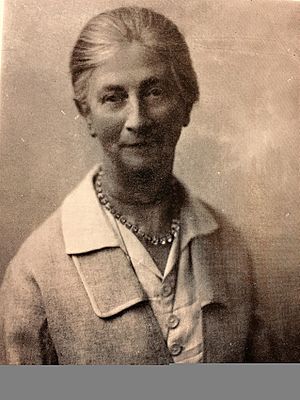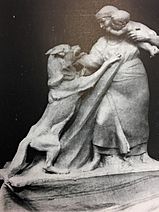Katherine Wallis facts for kids
Quick facts for kids
Katherine Wallis
|
|
|---|---|

Wallis from A Biographical Sketch of Katherine E. Wallis a Canadian Sculptor by Roger Collins
|
|
| Born | 1861 Merino, Peterborough, Canada West
|
| Died | 1957 |
| Alma mater |
|
| Known for | Sculptor, painter, poet |
Katherine Elizabeth Wallis (1861–1957) was a talented Canadian artist. She was a sculptor, a watercolor painter, and a poet. Katherine traveled the world to learn about art and improve her skills. She is most famous for her amazing bronze sculptures of animals and babies.
Contents
About Katherine Wallis
Early Life in Canada
Katherine Wallis was born in 1861 in a small town called Merino, near Peterborough, Canada West. She grew up on a farm with her sister, Adah. Even though they lived on a farm, their family loved art. Katherine's mother enjoyed music and singing.
Katherine looked up to her mother's friends, like Catharine Parr Traill and Susanna Moodie. Another friend, the painter Anne Langton, also inspired her. For a short time, Katherine went to the Toronto Art School, which is now called OCAD University. But back then, there weren't many chances for women to become professional artists in Canada. Anne Langton told the Wallis sisters that if they wanted to achieve their dreams, they needed to go elsewhere. Katherine soon realized that she needed to travel to find more opportunities.
Studying Art in Scotland
In 1878, Katherine and her sister Susanna traveled to Scotland to visit family. Katherine enrolled in the Edinburgh School of Arts. She also worked at the Scottish National Gallery. There, she made copies of famous artworks to earn money.
In 1880, Katherine's mother became ill. The sisters returned home to help with the family farm. Katherine stayed in Canada for thirteen years. After this time, she had enough freedom and money to go back to Europe and continue her art studies.
Learning Sculpture in London
In 1893, when she was 32, Katherine returned to Europe with her sister Adah. They first settled in Dresden, Germany. For two years, they traveled around Europe, looking at famous paintings, sculptures, and buildings.
In 1895, Katherine Wallis joined the Royal College of Art (RCA) in London. She was taught by a French sculptor named Édouard Lantéri. He helped Katherine discover her true passion: sculpture. Lantéri also taught her a style called "New Sculpture." This style focused on small bronze statues of everyday subjects, like women and small animals.
While studying at the RCA, Katherine won the RCA Bronze Medal. In 1897, she received a special scholarship that allowed her to study for two more years. After that, she decided to move to Paris.
Creating Art in Paris
In Paris, Katherine Wallis focused on making sculptures. She especially loved sculpting animals she saw at the zoo. She met Oscar Waldmann at the Jardin des plantes, a famous garden and zoo in Paris. He encouraged her to show one of her sculptures at a big art show called the Exposition Universelle. This helped her art become more recognized. Katherine also showed her work at the spring salon in Paris.
During this time, Katherine studied animals closely. She sculpted them using stone, marble, and bronze. In 1902, she met the famous sculptor Auguste Rodin. He encouraged her to sketch sculptures at the Louvre museum. Rodin admired how strong and well-built her figures were. He wanted to see more of her work. However, Katherine declined because her sculptures were too heavy to move. She also felt she already had great teachers like Lantéri and Waldmann.
When World War I started in 1914, Katherine stopped sculpting. Instead, she worked as a nurse in a Canadian hospital in Paris to help with the war effort. Her art was supposed to be shown in Toronto, but it was delayed because of the war. After World War I ended, Katherine went back to her art career.
In 1929, she made history. She became the first Canadian woman elected as a Sociétaire of the Société National des Beaux-Arts for her sculpture La Lutte Pour la Vie. In the 1920s, she spent three years showing her art in Peterborough, Ontario, before returning to Paris. She also spent five months in Bosnia and Greece, working on relief sculptures and watercolors. She sent her artworks to England, and within a year, her sculptures were shown in London, Liverpool, Leeds, and Glasgow. In 1936, when World War II began, she moved to California, where she lived for the rest of her life.
Life in Santa Cruz
The Santa Cruz Art League invited Katherine Wallis to have her own art show, and she accepted. She had a big show in the Santa Cruz Auditorium. Katherine also became a member of the National Society for Sanity in Art. This allowed her to show her work once a year in San Francisco and Chicago. Through this society, she won an award for Excellence in Sculpture twice!
In 1944, Katherine showed her sculptures Coming Always Nearer and Speed at the Santa Cruz Art League's Fifteenth Annual Exhibition. Later that year, she created a piece called Victory. It showed a smiling woman carrying a dove and holding an olive branch, symbolizing peace.
Achievements and Famous Works
Katherine Wallis had many important art exhibitions. She showed her work at the Royal Academy in London in 1897. Her art was also displayed at the Royal Canadian Academy from 1904 to 1937, and at the National Gallery of Canada in 1928. She received an honorable mention for her sculpture at the Exposition Universelle.
Katherine was not only a great sculptor, but also a talented painter and poet. Her poems were published in a collection called Chips from the Block. In 1947, the National Gallery of Canada bought Wallis's most famous sculpture, La Lutte pour la Vie. When she passed away, she gave her art collection to the City of Peterborough. You can now see it at the Peterborough Museum and Archives.



